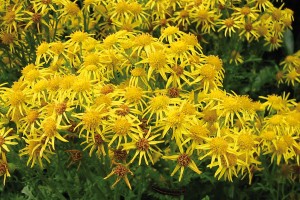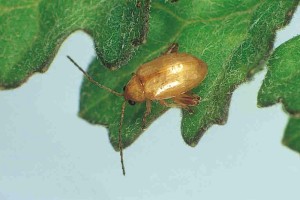Ragwort plume moth
History in New Zealand
The ragwort plume moth is native to Europe and was imported from Australia in 2005 by Manaaki Whenua - Landcare Research, in conjunction with the West Coast Ragwort Control Trust, because existing agents were not able to control ragwort in areas of higher rainfall. The plume moth is commonly found on marsh ragwort (Jacobaea aquatica) and therefore is well adapted to wet climates and is therefore expected to be well suited to areas like the West Coast of the South Island. Releases began in 2006, and the moth is now well established in much of New Zealand, removing ragwort as it was hoped it would.
How would I find/recognise it and what is its lifecycle?
The adult moths are pale brown with darker markings on the wings and are about 9 mm long. The moth is named for its hind wings, which have three feather-like plumes. Moths are nocturnal and are particularly active at dawn and dusk, but you may see them resting on ragwort plants during the day with their wings outstretched to form a T shape.
Females begin egg-laying in spring and lay about 100 eggs each. You will usually find eggs on the underside of mature ragwort leaves, either singly or in small groups, but occasionally also on the upper surface near leaf veins. When first laid, the tiny oval eggs are bright green and later turn pale yellow.
Image: ragwort plume moth eggs.
Newly hatched caterpillars are ivory-white or pale yellow. They burrow into the leaf stalks until they reach the crown of the plant. Larger caterpillars are pale green with small dark spots and are slightly hairy. They become darker green as they develop, passing through five growth stages, and are about 2 cm long when full-grown. Older caterpillars tunnel into the crown, stems and roots of ragwort, and you will need to pull some damaged plants apart to see them. Look for plants that have wilted or blackened or blemished shoots.
Image: ragwort plume moth larva.
Image: darker green ragwort plume moth larva.
The brown pupae can be found in stems or curled leaves, and in surrounding litter or soil. They hatch after about a week and the new adults produce a second generation in autumn. Caterpillars produced late in the season spend winter inside the root crown and then complete development and pupate the next spring. In some years, a third generation may be produced.
Ragwort plume moths are easy to differentiate from other ragwort biocontrol agents and insects found on ragwort.
See Ragwort flea beetle, Cinnabar moth.
Blue stem borer (Patagoniodes farinaria) larvae may also be found in stems and reach a similar size to plume moth larvae but are a distinctive bluish colour. The maggots of a fly (Melanagromyza senecionella) may also be seen in stems but are much smaller white grubs.
How does it damage ragwort?
The caterpillars are the damaging stage and can severely harm the crown and roots of ragwort plants. Attack by as few as 2–3 larvae can kill a plant. If plants are not killed, then they produce fewer flowers and seeds.
Will it attack other plants?
It is extremely unlikely that the moth will damage any plants other than ragwort (Jacobaea vulgaris) and marsh ragwort (Jacobaea aquatica), which is also a minor weed in New Zealand, and hybrids of these two species.
How effective is it?
There have been no studies to determine the effect of the moths on ragwort populations in New Zealand. However, a reduction in ragwort has been commonly observed within a few years of the moth being released at sites. In Australia, ragwort density
has been reduced by 60–80% at some sites after only 1–2 years. It may take up to 5 years before the impact of the moth becomes noticeable. The moth, flea beetle and ragwort have all become a relatively rare in much of New Zealand now due to their impact on ragwort plant populations.
How can I get the most out of it?
The moths probably fly less than a kilometre per year. You can accelerate dispersal by moving caterpillars to new areas.
How do I select a release site?
Read Guidelines for selecting release sites for biocontrol agents.
A suitable site would be at least 50 m × 50 m. Do not allow stock to eat the ragwort, if necessary, use temporary fencing.
How do I collect it for release at other sites?
Read Guidelines for collecting, relocating, and releasing insect biocontrol agents.
The best time to shift the moth is in late spring. Dig up damaged plants, roots and all, and put them in a chilly bin. Retain as much of the surrounding soil as possible as it may contain pupae. The more caterpillars and/or pupae you can shift, the greater the chance they will establish, and we recommend shifting at least 50–100 plants. At the release site, place one or two infested plants beside a healthy ragwort plant so any caterpillars can crawl across. Do not overload plants.
How do I manage the release sites?
Do not spray, heavily graze or cultivate this area for at least 2 years, to allow the moths to increase in number so they can be harvested for redistribution to other areas and begin to spread to surrounding areas.

